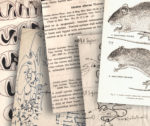Urban rodents of the city of Diamante, Entre Ríos, Argentina
Malena Maroli, Isabel Gómez VillafañeSome native cricetid rodents are well adapted to modified environments; therefore, they could inhabit periurban or even urban environments. The city of Diamante is a small riverside city immersed in a matrix of wetland and croplands which are inhabited by cricetid rodents. This city could offer available habitats to island rodents principally during extreme flood events. The objective of this study was to determine the composition of the rodent assemblage in this small riverside city of Diamante, Entre Ríos, Argentina, not studied so far, after an exceptional magnitude flood mediated by an ENSO-El Niño event. Small rodents were live-trapped in autumn and spring 2016 in 127 sampling units (houses and vacant lots). The relationship among rodent abundance and the minimal distance to the Paraná river and to boundaries of the city, and the presence of dogs, cats, chickens and litter were explored by means of Generalized Linear Models. Mus musculus and Rattus rattus were captured in 18.7% and 1.9% of the sampling units, respectively, while R. norvegicus and Oxymycterus rufus were found in 0.9% of these. Mus musculus abundance was not associated with its presence in houses or vacant lots or with any other explanatory variables. This study showed that this riverside city does not harbor populations of native rodents, not even in extreme flooding periods.
Roedores urbanos de la ciudad de Diamante, Entre Ríos, Argentina. Algunos roedores cricétidos nativos se adaptan bien a ambientes modificados; por lo tanto, podrían habitar entornos periurbanos o incluso urbanos. El objetivo de esta investigación fue determinar la composición del ensamble de roedores en una pequeña ciudad ribereña inmersa en una matriz de humedales y tierras de cultivo. El estudio se realizó en la ciudad de Diamante, Entre Ríos, Argentina, y fue el primero en su tipo. Esta ciudad está rodeada de islas del río Paraná habitadas por roedores cricétidos y, durante esta investigación, se produjo una inundación mediada por el ENSO-El Niño de magnitud extraordinaria. Se realizó un muestreo de pequeños roedores en otoño y primavera de 2016 en 127 casas y baldíos de la ciudad. La relación entre la abundancia de los roedores y la distancia mínima al río Paraná y a los límites de la ciudad, y la presencia de perros, gatos, gallinas y basura fueron exploradas mediante Modelos Lineales Generalizados. Mus musculus y Rattus rattus se capturaron en el 18.7% y 1.9% de las unidades funcionales, respectivamente; mientras que R. norvegicus y Oxymycterus rufus se encontraron en el 0.9% de estas. Ni el tipo de unidad funcional ni las demás variables explicativas se asociaron a la abundancia de M. musculus. Este estudio demostró que esta ciudad ribereña no alberga poblaciones de roedores nativos, ni siquiera en períodos de inundaciones extremas.
